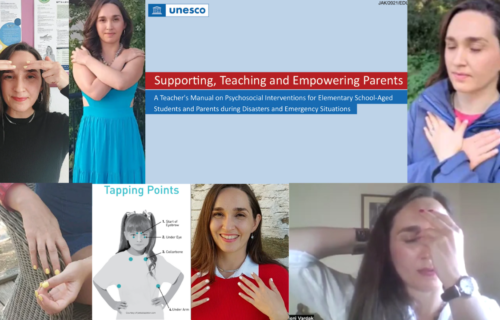
Personal Development Books for Empaths
WHAT’S THE ISSUE: With the increased levels of global anxiety and stress as the COVID19 virus spreads all over the world, there can be moments in the day where it all feels really overwhelming. For those of us who are empaths, this can be a particularly difficult time on the emotional level; we have an above average ability to feel people’s energy when we walk into a room or tune into a Skype/Zoom call, and to put ourselves in other people’s ‘shoes’. Fortunately, there are brilliant books for empaths out there that can help us navigate the challenges we face in the world today.
While it’s important for all of us to step up emotional self-care routines in these uncertain times, it’s absolutely vital for those of us who are empaths; our knee-jerk reaction is often to put others’ safety mask on first, before we wear our own. If we want to come out of this crisis emotionally and psychologically healthy, which we need to be in order to be of service to our families and the world, we’ve got to change our ways.
In this article, I talk about the five books I find myself recommending the most frequently to my adult clients in my private practice (and yes, I mostly work with empaths). As an empath myself, I’ve found these books to be life-changing. Every one of these 5 books has challenged me to open my mind by challenging my (rather naive) preconceived notion of the world around me. I hope you find them as interesting as I have.
TOP 5 BOOKS FOR EMPATHS

1) Dr Gabor Mate: When THE BODY SAYS NO
This was one of the hardest books I’ve ever read (there were tears) – but it’s certainly the one I recommend the most to any empath who wants to better understand ‘mystery’ illnesses like chronic fatigue, cancer, fibromyalgia through a scientifically-informed, big picture view of the stress-disease connection.
In When the Body Says No: The Cost of Hidden Stress, Gabor Mate’s writes about the science of stress and the effects of chronic stress on the body. He uses real life examples to illustrate the connection between ‘hidden’, unprocessed emotional stress in our body, and physical pain and illness. In this book, Gabor Mate documents case after case of how relational stress, character traits, and unattended emotional stress interact. I think it’s well worth the challenge of reading through the heartbreaking stories of case after case of patients Gabor Mate worked with to better understand the science of stress and to increase your body intelligence.
One of the biggest take-aways, for me, of reading this book was a heightened awareness of the science behind the link between the character trait of hyper-conscientiousness, a history of emotional suppression (particularly suppressing your anger), and the way the body can manifest unprocessed, chronic emotional stress that’s been stuck in the body for far too long. I knew that there was a connection between recurring physical pain (headaches, tension in the back of the neck, back pain, tooth gritting) and suppressed emotion because I keep seeing people relieved from physical aches and pains as we work together to process the emotion that was suppressed in their body via the Emotional Freedom Technique. What I wasn’t aware of, before reading this book, was the science behind this link, and why empaths in the hyper-conscientious range of character formation can be at greater risk of developing serious illnesses and chronic pain conditions, on average.
After reading When the Body Says No, I’m troubled by how limited the scope and provision of character education is schools, right now. If you’re a teacher or a school leader, think of how much of our time and energy as teachers and schools leaders is sucked by students who attention-seek through bad behavior (some of whom are showing early signs of potentially developing what Dr George Simon refers to as character disorders through their displays of serious anti-social behavior)….and how, as a result, we neglect the special emotional needs for time and attention of the really nice, quiet ones who you can count on to keep their head down and do the work. We’re neglecting the emotional needs of the empaths in our class. The hyper-conscientious ones, who also need our attention. Yet all we ever seem to talk about in the staff meetings are the ‘Causes for Concern’ (which, 9 times out of 10, is narrowly defined as someone who is academically underachieving and/or displaying anti-social behavior of various degrees of severity).
But what about the high-achieving empaths who don’t want to feel like they’re a burden to anyone, who’s long-term health and wellbeing may be at risk if they don’t learn how to have self-compassion and process painful emotions, like anger? Just because their emotional and wellbeing needs are less urgent, as they don’t disrupt the lesson, doesn’t mean we should neglect them. Being able to get in touch with your suppressed anger so that you can release it in a safe and gentle way using techniques like tapping is important for long-term health and wellbeing. Schools need to stop dismissing these students’ needs with a wave of the hand and a passing, “Oh, they’ll do fine in the exam”. There’s more to education than being an exam-factory.
Dr Gabor Mate’s book is also a wake-up call for teachers and parents who are empaths to start investing more time and energy into learning how to improve their own health and wellbeing. First must first put our own ‘safety mask’ on, before we can help others. We must take a stronger stand for the hyper-conscientious students who don’t understand the importance for their long-term health of getting in touch with, and processing, suppressed anger in the body.
When the Body Says No, we must learn to listen, and to understand what our body’s intelligence is trying to say to our heart and brain.
2) DR ARUN GANDHI: THE GIFT OF ANGER
I used to think anger was all bad. But I was wrong, because I had an overly-simplistic understanding of anger.
The Gift of Anger is a book written by one of Mahatma Gandhi’s grandsons, Arun Gandhi. This book invite you to deepen your understanding of anger as an emotion. Anxiety, panic attacks – these emotions are a worry. They’re a sign we’re in the danger zone of stressed and overwhelmed. But anger, when experienced in response to an injustice (racism, sexism, emotional or physical abuse, ageism, etc) is HEALTHY! It’s our body’s way of telling us: something is wrong here. It’s valuable for us to learn to listen to this information.
Anger, in and of itself, isn’t aggression. Anger is simply information. When empaths start to have more and more anger outbursts, it’s our body is telling us to ‘pay attention’, because something is off. Something needs to change. When you tap into what the anger is trying to tell you, often what you’ll find is your body is telling you that a personal boundary has been violated, or that something in your life needs to change. Ask yourself: What is my anger telling needs to change in my life? It could be as simple as “I need to sleep more”, or “I need to take better care of myself.”
If you’re a History buff like me, you’re going to appreciate the fascinating window into Mahatma Gandhi’s life. I enjoyed learning about the inspiring way he taught his grandson, Arun Gandhi, about the gift of anger. This book is essentially a summary of the wisdom Arun Gandhi learnt from his grandfather. I think Arun Gandhi does a fabulous job of using stories from his childhood growing up with Mahatma Ghandi to explain the value – the gift – of his anger, and how anger can be transformed into a positive force for change in society through story-telling telling and healthy relationships.
The Gift of Anger helped me to deepen my understanding of anger. I now appreciate the incredible value of anger as an emotion. The more I develop my personal and professional experience of tapping into the power of anger to transform and act as a catalyst for change, the more I appreciate this book. When we get in touch with our suppressed anger in a healthy, constructive way, we can see how suppressed anger can be used as a tremendous force for good.
I often recommend this book to my clients who are burdened by feelings of guilt or shame associated with their feelings of righteous anger. Through my private practice, I’ve learnt that it’s common for women to shame other women (and for men – fathers, husbands, boyfriends – to shame their wives, daughters, or girlfriends) simply because they expressed their anger. As a result, a lot of my clients come to me having developed a blocking belief that all anger is bad, which leads them to suppress righteous anger and cuts them off from having access to this fuel for personal empowerment. From my experience of tapping with adults, I’ve noticed that anger tends to manifest itself as chronic or recurring pain in the lower back. I’ve found that reading Arun Gandhi’s book, in combination with a systematic somatic approach for releasing suppressed anger like the Emotional Freedom Technique, can do wonders for helping to relieve lower back pain. There can be serious long-term health consequences of leaving hidden emotional stress like suppressed anger go unchecked in your body; we know that there’s often a link between chronic health conditions and suppressed anger. We also know that there’s often a link between suppressed anger and clinical depression.
If you want to take a deep dive into the nuances of understanding anger as an emotion, I recommend reading The Gift of Anger alongside one of Dr Simon’s books (see my next two recommendations). I think you’ll find the connections you make when layering what Dr Simon’s clinically-informed work has to say on anger over Dr Arun Gandhi personal insights on anger enlightening.
I once worked with a colleague who said he wanted to spend the last 10 minutes of their lunch break ‘winding themselves up’ so that he could get anger and come down hard on his students for failing to do their homework on time, at the start of the upcoming lesson.
This is an example of premeditated anger. It’s aggressive in nature.
It’s very different to the defensive, reactive angry outburst of a teacher feels who’s students are harassing them by hiding the remote control for the projector and acting like no one knows where it’s gone, making it difficult for him to do his job and start the lesson. The righteous anger a teacher feels when they are being bullied by a student who’s using emotional harassment to increase their predicted grade is healthy. Pre-meditated anger is unhealthy.
As Dr George Simon clearly explains in both Character Disturbances and In Sheep’s Clothing (see below), what’s problematic is when people fight dirty by using anger as a manipulation tactic to intimidate people into getting their way. In both of these books, Dr George Simon makes an important distinction between defensive, reactive anger and aggressive, premeditated aggression that I think is particularly important for empaths to understand.
3) DR GEORGE SIMON: IN SheeP's CLOTHING
In Sheep’s Clothing: Understanding and Dealing with Manipulative People is an important reminder to empaths that not everyone thinks the way we do. In this book, Dr George Simon explains how manipulative people, people who habitually display covert aggression in how they behave and interact with the people around them, use manipulation tactics to fight dirty.
One of the problems American society faces right now, Dr George Simon, is that too many Clinical Psychologists who were trained to believe that ‘all hurt people hurt people’ assume that these aggressive personalities are doing so out of some deep inner pain, such as low self-esteem and feelings of inadequacy….when in fact, the exact opposite is true.
Blinded by the manipulation tactics covert aggressive personalities so often use, such as playing the victim, you’ll even find that there are Clinical Psychologists who are manipulated by such personalities pulling the wool over the eyes of their empath therapist. If you aren’t aware of the fact that there are people with disorders who use manipulation tactics to avoid taking responsibility for their bad behaviors, you can fall victim to their manipulation tactics. This results in people being treated as being mentally ill, when they’re not (and therefore the therapy has no impact); because the real issue isn’t that they’re mentally ill, the root of the issue is their character.
As you read this book, you will gain a deeper understanding of why Dr George Simon argues that the information he’s shared is important not only for Psychologists and other health practitioners to understand, but also for lay-people. In a sense, it’s a book on relationships skills, and on understanding how, where, with whom and why we need to set strong interpersonal boundaries.
I see this as a book that educates you on how to be a better judge of character, and how to avoid the pitfall of misunderstanding who is the victim and who the victimizer in any given scenario. I believe it’s particularly useful for anyone involved in education; if you’re a teacher (especially in secondary school, where we know that the early signs of a possible adult personality disorders start to appear in the teenage years), you will have had a wealth of experience investigating cases of bullying. As teachers, we’ve seen a lot of bullying in the classroom, or while observing students behavior during a lunchtime duty. We’re experienced in filling out incident forms where we had to report a case of bullying where the child who was bullying a classmates played the victim (and never showed any guilt or remorse for their wrongdoing) as a manipulation tactic to try and avoid taking responsibility for their bad behavior (and therefore, avoid getting punished).
Having worked in the trenches of a toxic school environment when I was living in the UK (before I came to teach in Greece), I’ve gained a wealth of experiential knowledge from observing the examples of covert manipulation tactics George Simon mentions in his book. I’ve observed all of the covert aggression tactics mentioned in this book from having to continually confront aggressive, badly behaved students in the classroom and on the playground, while working in a school where violence was the norm. So I’ve observed the problematic behaviors that Dr George Simon describes, from the educational perspective of a teacher. But reading In Sheep’s Clothing has helped me understand what I saw in that school from a psychological perspective.
Here’s one of the big take-aways I got from reading In Sheep’s Clothing: we’ve got to stop over-generalizing and misunderstanding the problem of student well-being by assuming that all adolescents and young adults who display covert or overt aggressive behaviors have low self-esteem. This misunderstanding is damaging to a child’s chances of being able to successfully socialize and integrate into society, let alone their chances of experiencing meaningful academic success.
Lay people like you and I obviously lack the qualifications, skill and knowledge to be able to diagnose someone with a mental illness or a personal disorder. But what we most certainly can do is to educate ourselves and develop are our skills and ability to observe and identify covert aggressive patterns of behaviour. This is an important part of effectively address the wellbeing issues that we see in our world, today.
4) Dr GEorge Simon: Character DistUBrance
Character Disturbance: The Phenomenon of Our Age is a more advanced version of In Sheep’s Clothing. So if you want to go straight into the deep-end and read a comprehensive book on empaths and on character education from the perspective of a world-renowned Clinical Psychologist, this is the one for you.
While there were moments when the case studies that Dr George Simon shared of what psychopaths and sociopaths had said or done were so horrifying and difficult to read that it was incredibly hard for me to keep reading, as an empath (I was this close to stopping, half-way through), I’m glad I persevered and made it to the end of the book.
If you stick it out and read all the way to the end of Character Disturbance, I think you’ll find that the last chapter is an absolute gem of a chapter for anyone who cares about how we can help make the world a better place through character education.
For those of us who work in secondary schools, we’ve seen a rise in behavior issues in the last 10 years of more and more students leaving school displaying irresponsible behavior. In the private schools sector, this avoidance of student responsibility can manifest in the form of too much private tutoring (with a child’s parents often complicit in enforcing or enabling this rise of academic irresponsibility).
The rising trend of private tutoring (all too often a crutch for students who want to remove responsibility for their failure/success by displacing some of their student responsibilities onto the tutor) is one example of this rise of irresponsible behavior.
At around this time last year, I wrote an article called “Is Too Much Tutoring Spoiling Our Kids?” where I shared some shocking examples of irresponsible behavior, such as the day I got a call from a mother who wanted to hire me to do her son’s externally-assessed coursework for him. Apparently, her son had had more important things to do in his life than to behave responsibly and work his way to academic success in an ethical way. When I asked why her son needed my help, I was informed in a rather blaze way that he found the subject boring and felt that it was waste of his time.
Here’s another example of student behavior that brings up issues of character education: I once spoke to a mother of 3 who was shocked by what her youngest son told her, on the way home from school one day. He was still a Primary School student, at the time. On the way home, he told his mum that there were kids who got one of the Primary School teachers in his school fired.
More and more, we see this kind of behavior where kids bully teachers at work starting at younger ages than we’ve ever seen before, and the rising character-related causes for concern we’re seeing in education is, according to Dr Simon George, part of a wider trend in society. And while Dr George Simon’s conclusions are based on his work as a Clinical Psychologist in the United States, the fact that his books have been best-sellers worldwide for years is a sign that the issues he discusses resonate with an international audience and constitute a global issue that affects us all, one way or another.
We can work to reverse the trend of increasing numbers of students leaving school behaving irresponsibly. The final chapter of Character Disturbance is filled with practical advice that’s particularly useful for empaths who want to help make the world a safer and happier place for all.
However, if you skip the hard part of reading the previous chapters, I think you’ll miss the value of understanding exactly why Dr George Simon recommends the principles for character education that he does, at the very end.
Before we jump to the solution, we need to accurately understand the precise nature of the wellbeing problem we are facing in education right now, and in the world at large.
5) Dr ChristiANE NORTHRUP: DODGING ENERGY VAMPIRES
Dodging Energy Vampires: An Empath’s Guide to Evading Relationships That Drain You and Restoring Your Health and Power is an interesting book written by Dr Christiane Northrup, who is a world-renowned expert in women’s health.
After starting her journey in women’s health in conventional medicine, Dr Christiane Northrup noticed a pattern in patients who conventional medicine dismissed as having ‘mystery’ illnesses such as chronic fatigue, fibromyalgia, breast cancer, and so on: that common factor had to do with the draining relationships these women were in, either at work or in their intimate relationships (or both!).
Increasingly, Northrup became concerned with the limits of conventional medicine when she started to apply what she learnt at college to her work with patients. She was particularly concerned by how conventional medicine (and the pharmaceutical industry that profits massively from the tenets of conventional, drug-based medicine) is focused on the reactive study of disease rather than on the pro-active study of what makes us healthy to prevent getting the disease in the first place. Dr Northrup has made it her life mission to focus on educating women on how to achieve optimal health through a holistic approach that encompasses taking a good hard look at the relationships in your life that may be draining you from your vitality and life force.
In Dodging Energy Vampires, Northrup explains how, through experiential knowledge, she noticed something conventional medical studies doesn’t care to investigate; the impact that choosing to stay in toxic relationships, particularly intimate relationships, can have on your health and wellbeing. In conventional medicine, doctors are trained to diagnose and prescribe drugs. They are not trained to spend a medical consultation investigating what the root causes of their patient’s ill health might by doing a more attentive investigation into their life histories and how a significant other, or relationships at work, may be affecting their health.
One of the key take-aways I got from reading Dodging Energy Vampires is a newfound understanding of the relationship dynamics that can lead empaths to attract what Dr Northrup refers to as ‘energy vampires’ – people who drain the energy and life force out of an empath. In her medical practice, she noticed that empaths, conscientious people, were prone to fall for what she calls these responsibility-shirking ‘energy vampires’, by which she means what some call the Dark Triad: Narcissists, Sociopaths, and Psychopaths. She also noticed that when empaths staying in these relationships for too long, their health suffered.
I believe there is great beauty and power in being a sensitive person. The more we own it, and the more we educate ourselves on what our particular wellbeing needs are (particularly with regards to our relationship needs), the more we can set healthy boundaries in our relationships and attract the kinds of personal and professional relationships that resonate with our soul.
For me, one of the most valuable chapters in Dodging Energy Vampires for heart-centred souls is the one called “The Health Risks of Unbalanced Relationships”. In this chapter, Dr Northrup explains some of the links between recent developments in the fields of biology, Psychology, as well the unhealthy relationship dynamics between empaths and people she calls “energy vampires” (psychopaths, sociopaths, narcissists).
If you do decide to read it (or have already read it), I’m curious to know which of the chapters you found most enlightening and interesting, and why. Leave a comment at the end of this article and let me know!




